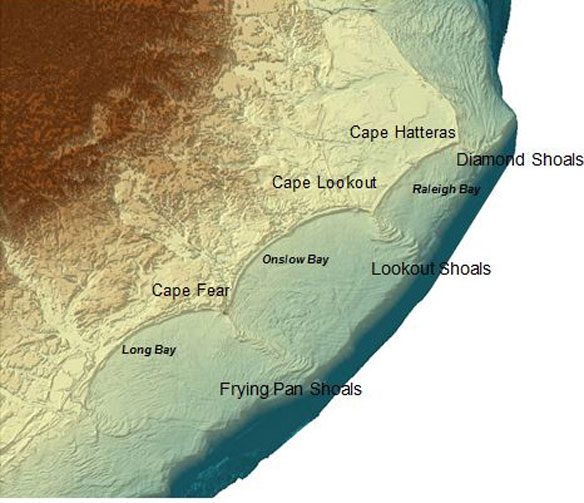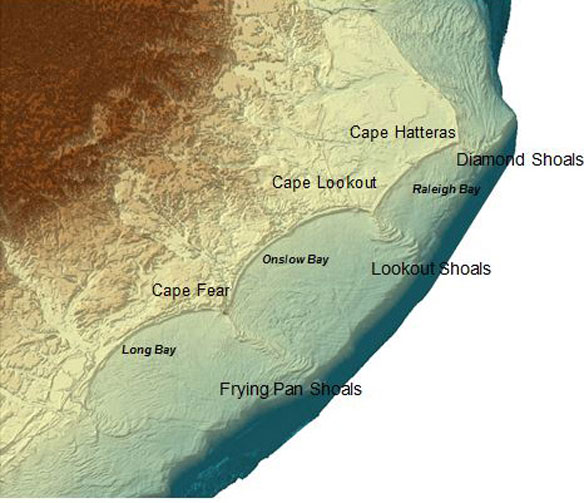
Systems of shoals extend seaward from, north to south, Cape Hatteras, Cape Lookout and Cape Fear. Map source: U.S. Geological Survey
Excerpts;
Senate leaders hit the brakes last week on a fast-moving set of amendments to state environmental laws with several coastal-related provisions, including one that would for the first time target North Carolina’s three great capes as a sources of sand for beach re-nourishment.
Among the coastal provisions is a move to allow cape shoals to be tapped as sources of sand for beach-fill projects and to exempt material from those areas from the sand-quality standards for re-nourishment and other projects.
An attorney for the Southern Environmental Law Center, said the provision would create a significant exemption from the current rules and open for sand mining areas that include rocky material…
Read Full Article, Coastal Review
Economy Winner, Environment Loser in Renourishment; Pensacola News Journal (12-02-2015)
Editorial: Beach Replenishment is No Cure-All, Asburry Park Press (05-14-2015)
Is Beach Renourishment Worth The Money? WWAY News (02-16-2015)
Piling sand to stop erosion ultimately made the land sink, study says, NOLA (12-26-2015)
Living shorelines a more natural approach to preventing coastal erosion; (05-18-2016)
For centuries, large bulkheads have been used to help control erosion along coastlines. More recent research suggests that a natural approach may be a better alternative. Having nature on your side, especially during a storm or hurricane, is proven to provide better protection from coastal erosion…
Cemex mine reflects human hunger for sand, California; Monterey County Now (01-14-2016)
The disappearance of the beach reflects an alarming reality: Southern Monterey Bay, Marina in particular, has the highest coastal erosion rate in the state of California. For more than 20 years, scientists have speculated about the sand mine’s contribution to that erosion rate, and a 2008 study concluded it was the primary cause. The Cemex mine in Marina is the only remaining coastal sand mine in the entire United States. Which leads to new questions…
Sand, Rarer Than One Thinks: A UNEP report (GEA-March 2014)
Despite the colossal quantities of sand and gravel being used, our increasing dependence on them and the significant impact that their extraction has on the environment, this issue has been mostly ignored by policy makers and remains largely unknown by the general public.
In March 2014 The United Nations released its first Report about sand mining. “Sand Wars” film documentary by Denis Delestrac – first broadcasted on the european Arte Channel, May 28th, 2013, where it became the highest rated documentary for 2013 – expressly inspired the United Nations Environment Programme (UNEP) to publish this 2014-Global Environmental Alert.









